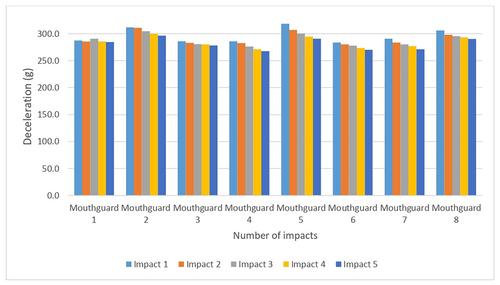Comparison of shock absorption capacities of three types of mouthguards: A comparative in vitro study
Abstract
Background/Aim
3D printing processes can be used to manufacture custom-made mouthguards for sports activities. Few studies have compared the impact performance of industrial-created mouthguards with that of custom-made mouthguards manufactured by thermoforming or 3D printing. The objective of this in vitro study was to compare the shock absorption capacities of custom-made mouthguards manufactured by 3D printing with industrial mouthguards and thermoformed ethylene vinyl acetate (EVA) mouthguards.
Materials and Methods
For each type of mouthguard, eight samples were produced. 3D-printed mouthguards were manufactured using digital light processing technology. Each mouthguard was subjected to an impact performance test defined by the standard AFNOR XP S72-427, which evaluate maximum deceleration and force transmitted during impact. The thickness of each mouthguard before and after a series of five impacts was measured at the impacted inter-incisal area.
Results
The mean maximum decelerations during impact ranged from 129 to 189 g for industrial mouthguards, 287 to 425 g for thermoformed EVA mouthguards, and 277 to 302 g for 3D-printed mouthguards. The mean reduction in mouthguard thickness at the impact zone after five tests was 1.2 mm for industrial mouthguards, 0.6 mm for 3D-printed mouthguards, and 2.2 mm for thermoformed EVA mouthguards.
Conclusions
Custom-made 3D printed mouthguards showed slightly better shock absorption ability than thermoformed mouthguards with respect to the indicator proposed in XP S72-427. They seemed to combine the practical advantages of thermoformed mouthguards in sports with better shock absorption capacity and lower cost. Furthermore, they had the least thickness variation during the test, and their shock absorption capacity was the least affected by repeated mechanical tests. Other types of 3D-printing resin materials that will become available must continue to be tested for shock absorption to provide the best protection to users at low cost.


 求助内容:
求助内容: 应助结果提醒方式:
应助结果提醒方式:


